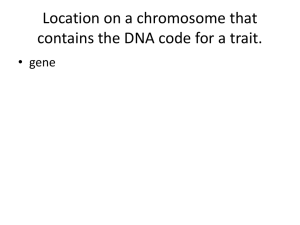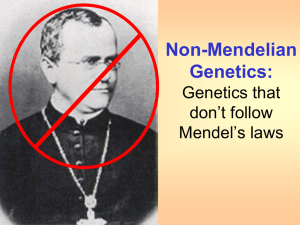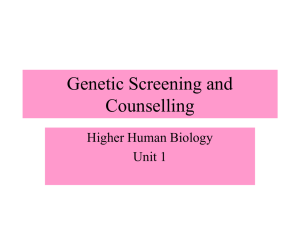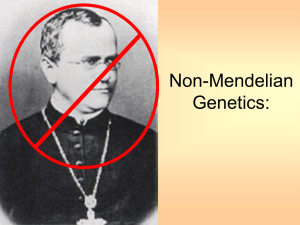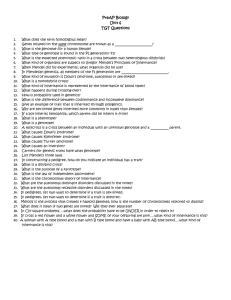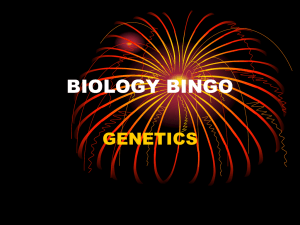Twenty-two questions to test your understanding of SL Genetics
advertisement
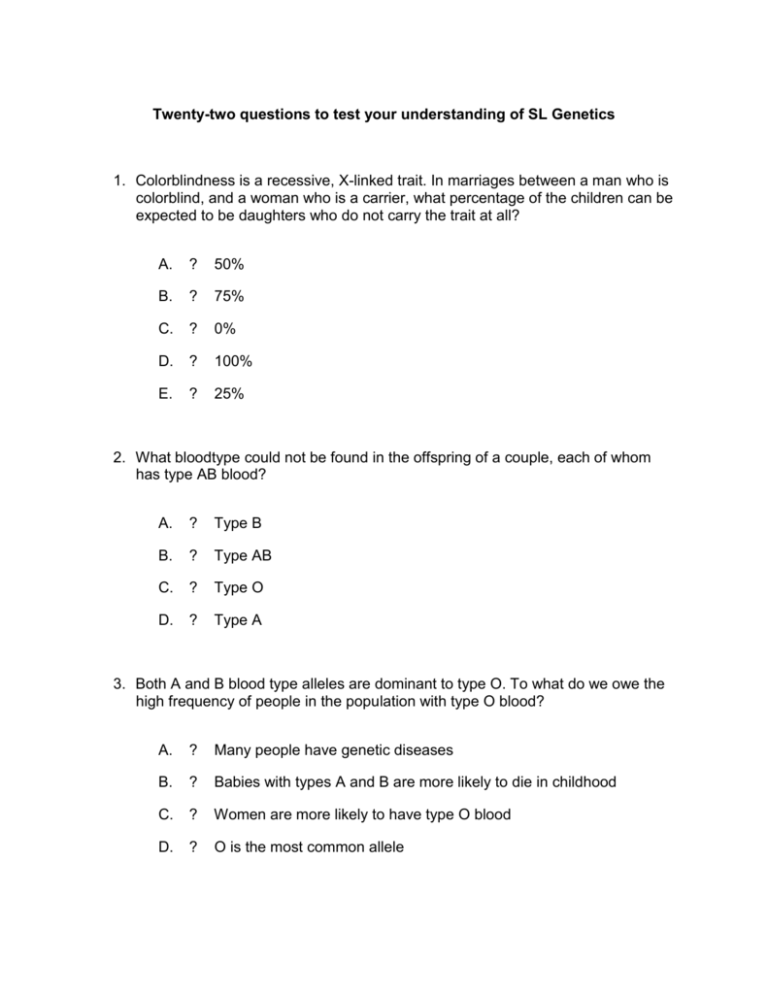
Twenty-two questions to test your understanding of SL Genetics 1. Colorblindness is a recessive, X-linked trait. In marriages between a man who is colorblind, and a woman who is a carrier, what percentage of the children can be expected to be daughters who do not carry the trait at all? A. ? 50% B. ? 75% C. ? 0% D. ? 100% E. ? 25% 2. What bloodtype could not be found in the offspring of a couple, each of whom has type AB blood? A. ? Type B B. ? Type AB C. ? Type O D. ? Type A 3. Both A and B blood type alleles are dominant to type O. To what do we owe the high frequency of people in the population with type O blood? A. ? Many people have genetic diseases B. ? Babies with types A and B are more likely to die in childhood C. ? Women are more likely to have type O blood D. ? O is the most common allele 4. In all conditions in which a defective gene is on the X chromosome, transmission to a male can be: A. ? from neither his mother nor father B. ? only from his father C. ? only from his mother D. ? either from his father or his mother 5. Colorblindness is a recessive, X-linked trait. In marriages between a man who is colorblind, and a woman who is a carrier, what percentage of the children can be expected to be sons who are color blind? A. ? 25% B. ? 75% C. ? 0% D. ? 50% E. ? 100% 6. Colorblindness is a recessive, X-linked trait. In marriages between a man who is colorblind, and a woman who is a carrier, what percentage of the children can be expected to be daughters who are carriers of the trait? A. ? 0% B. ? 50% C. ? 25% D. ? 100% E. ? 75% 7. The pedigree above indicates that the trait in question is A. ? sex-linked B. ? autosomal recessive C. ? autosomal dominant 8. The image below is a partial pedigree for the inheritence of hemophilia in the royal families of Europe. 9. Based upon this pedigree, hemophilia is A. ? autosomal codominant B. ? autosomal recessive C. ? autosomal dominant D. ? sex-linked 10. A man with type A blood marries a woman with type B blood. Their three children have blood types A, B and O, respectively. What are the parental genotypes? A. ? Father: AA || Mother: BB B. ? Father: AO || Mother: BO C. ? Father: AO || Mother: BB D. ? Father: AA || Mother: BO 11. Colorblindness is a recessive, X-linked trait. In marriages between a man who is colorblind, and a woman who is a carrier, what percentage of the children can be expected to be daughters who are color blind? A. ? 100% B. ? 50% C. ? 25% D. ? 75% E. ? 0% 12. Colorblindness is a sex-linked trait that is uncommon in women because A. ? women have a different gene for color vision B. ? it is carried by a gene on the Y chromosome C. ? women have to receive the trait from both parents in order for it to be expressed 13. A father is heterozygous for a particular autosomal dominant trait. If his spouse is homozygous recessive for the same trait, what percentage of their offspring can be expected to express the dominant condition? A. ? 0% B. ? 25% C. ? 50% D. ? 100% E. ? 75% 14. Three babies were recently mixed up in a hospital. The blood types of the possible parents and babies are shown below. Parents Parents #1 #2 Parents #3 A and B A and A AB and O 15. Who are the possible parents of baby #1? Parents #3 Parents #1 Parents #2 Baby Baby Baby #1 #2 #3 B O AB 16. Three babies were recently mixed up in a hospital. The blood types of the possible parents and babies are shown below. Parents Parents #1 #2 Parents #3 A and B A and A AB and O Baby Baby Baby #1 #2 #3 B O AB 17. Who could not have been the parents of baby #2? Parents #2 Parents #3 Parents #1 18. Three babies were recently mixed up in a hospital. The blood types of the possible parents and babies are shown below. Parents Parents #1 #2 Parents #3 A and B A and A AB and O 19. Who are the possible parents of baby #3? Parents #2 Parents #1 Parents #3 Baby Baby Baby #1 #2 #3 B O AB 20. The term "sex-linked trait" almost universally refers to alleles with genes on the . ? 22 autosomes A. ? X chromosomes B. ? Y chromosome 21. In snapdragons, tallness (T) is dominant to dwarfness (t), while red flower color is due to gene (R) and white to its allele (r). The heterozygous condition results in pink (Rr) flower color. A dwarf red snapdragon is crossed with a plant homozygous for tallness and white flowers. What percentage of the offspring can be expected to have the tall, pink-flowered phenotype> . ? 75% A. ? 0% B. ? 25% C. ? 100% D. ? 50% 22. Colorblindness is a recessive, X-linked trait. In marriages between a man who is colorblind, and a woman who is a carrier, what percentage of the children can be expected to be sons who are not color blind? . ? 0% A. ? 75% B. ? 25% C. ? 100% D. ? 50%
